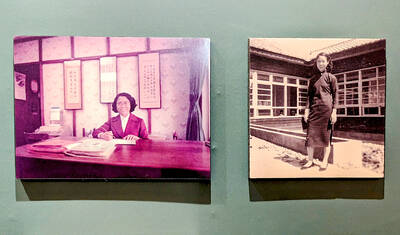The riot of color, patterns, fabric and plastic inside Cartoon House’s (卡通工房) narrow storefront on Yongkang Street (永康街) testifies to owner Betty Hsiao’s (蕭淑華) twin passions: vintage toys and clothing.
Hsiao has been collecting toys for two decades. She started seeking out figures based on her favorite childhood cartoons in ordinary toy stores before progressing to flea markets and auction houses in Tokyo and Osaka, where she frequently traveled while working at a clothing design company.
As a child, Hsiao watched Astroboy, Mazinger Z, Science Ninja Team Gatchaman and Popeye. Cartoon House, which opened 10 years ago, is also filled with vintage and new merchandise related to Betty Boop, Doraemon, Mickey Mouse, Snoopy, Kewpie dolls and the chubby-cheeked Peko Poko candy mascots, among other characters.
But it is clear that Hsiao’s heart belongs to Candice “Candy” White Ardlay (小甜甜), a bright-eyed, blond-haired teen who first appeared in Japanese comic books and cartoons during the 1970s. Backlit illustrations of Candy are lined up above racks of soft cotton smocks and knit shawls. Bags with her image silkscreened onto them dangle from hooks; framed portraits of Candy rest on top of a shelf; and a vintage wooden cabinet is filled with Candy dolls, as well as a children’s sewing machine with Candy’s face emblazoned on its side.
“I think I do like Candy Candy the best,” admits Hsiao with a giggle. “When I was a schoolgirl, her cartoons were on TV. They were aimed at young girls and that’s what I watched, so I’ve always been partial towards her.”
Candy Candy was introduced in 1975 by Japanese writer Kyoko Mizuki and by the mid-1980s had gained a worldwide following. The main character is an orphan known for her upbeat and loving personality. Candy had two major love interests: Anthony Brown and Terry Graham Grandchester, each of whom had their own team of supporters among Candy’s fans.
“Sadly, Anthony was killed in a riding accident,” says Hsiao. “It was very tragic. All his fans mourned.” Team Terry was also deprived of a happy ending when a legal dispute between Mizuki and Yumiko Igarashi, the illustrator responsible for Candy’s signature golden pigtails, button nose and sparkly green eyes, brought the series to a premature halt.
“It was really frustrating, but on the plus side, everyone has the freedom to write their own ending for Candy,” says Hsiao.
Many of Cartoon House’s regular customers are women who, like Hsiao, grew up with Candy Candy cartoons and comic books in the 1970s. But an increasing number consists of young mothers and their children, who have come to know Candy Candy through recently re-issued DVDs.
“Moms watch them with their kids, many of whom are very young, and they bring them here,” says Hsiao.
Hsiao says she has no idea how many vintage toys she owns — a portion is in Cartoon House, but her own home is filled with yet more items. Some toys she can’t bear to part with — like a mint condition, in-box Candy Candy doll from the 1970s that would normally retail for NT$25,000 — but most are for sale.
“I get the feeling that there aren’t a lot of Candy Candy things out there and that the collectibles are getting harder to find,” says Hsiao. “I want other people to be able to enjoy these toys. I think that’s the most important part. I’m not very possessive. I don’t even like taking photos, because I can keep the toys I’ve sold in my memory.”
Vintage toys available in Cartoon House range from small Kewpie dolls for NT$400 to tin wind-up robots that cost NT$10,000 each or more. In addition to going on toy hunts during her trips abroad, Hsiao brings back women’s clothing from Japan, Hong Kong, China and South Korea. Many of the dresses she sells look like they stepped out of the pages of a Japanese zakka magazine — cotton prints abound, as well as small flourishes like crochet collars, pin-tucks and lace-lined sleeves. The store also carries tote bags embroidered by Hsiao and quilted purses that she and her mother work on together.
“My mom is already very old and she’s not in the best of health. We wanted to find something productive for her to do, and she just happens to love quilting,” says Hsiao. “Sewing takes a lot of patience, but I studied fashion design, so it’s one of my passions.”
Clothing and accessories fill most of Cartoon House’s crowded shelves and racks, but it’s clear that Hsiao’s particular joy — and the heart of her store — are the cabinets filled with decades-old toys and figures.
“Toys can make your life more joyful. I think people who like design and art tend to be attracted to collecting toys,” says Hsiao. “It’s something that people become very passionate about, because toys are so cute and loveable.”

Following the shock complete failure of all the recall votes against Chinese Nationalist Party (KMT) lawmakers on July 26, pan-blue supporters and the Chinese Communist Party (CCP) were giddy with victory. A notable exception was KMT Chairman Eric Chu (朱立倫), who knew better. At a press conference on July 29, he bowed deeply in gratitude to the voters and said the recalls were “not about which party won or lost, but were a great victory for the Taiwanese voters.” The entire recall process was a disaster for both the KMT and the Democratic Progressive Party (DPP). The only bright spot for

Aug. 11 to Aug. 17 Those who never heard of architect Hsiu Tse-lan (修澤蘭) must have seen her work — on the reverse of the NT$100 bill is the Yangmingshan Zhongshan Hall (陽明山中山樓). Then-president Chiang Kai-shek (蔣介石) reportedly hand-picked her for the job and gave her just 13 months to complete it in time for the centennial of Republic of China founder Sun Yat-sen’s birth on Nov. 12, 1966. Another landmark project is Garden City (花園新城) in New Taipei City’s Sindian District (新店) — Taiwan’s first mountainside planned community, which Hsiu initiated in 1968. She was involved in every stage, from selecting

As last month dawned, the Democratic Progressive Party (DPP) was in a good position. The recall campaigns had strong momentum, polling showed many Chinese Nationalist Party (KMT) lawmakers at risk of recall and even the KMT was bracing for losing seats while facing a tsunami of voter fraud investigations. Polling pointed to some of the recalls being a lock for victory. Though in most districts the majority was against recalling their lawmaker, among voters “definitely” planning to vote, there were double-digit margins in favor of recall in at least five districts, with three districts near or above 20 percent in

The great number of islands that make up the Penghu archipelago make it a fascinating place to come back and explore again and again. On your next trip to Penghu, why not get off the beaten path and explore a lesser-traveled outlying island? Jibei Island (吉貝嶼) in Baisha Township (白沙鄉) is a popular destination for its long white sand beach and water activities. However, three other permanently inhabited islands in the township put a unique spin on the traditional Penghu charm, making them great destinations for the curious tourist: Yuanbeiyu (員貝嶼), Niaoyu (鳥嶼) and Dacangyu (大倉嶼). YUANBEIYU Citou Wharf (岐頭碼頭) connects the mainland